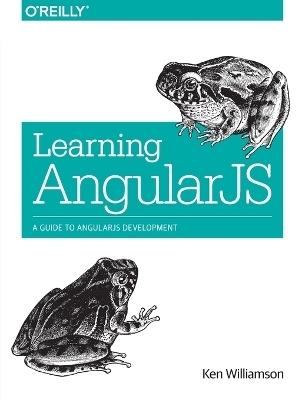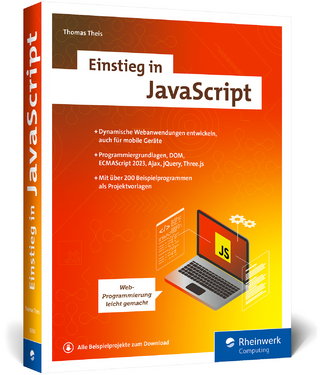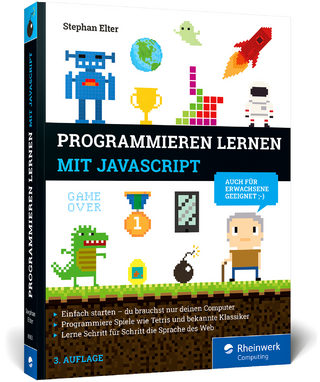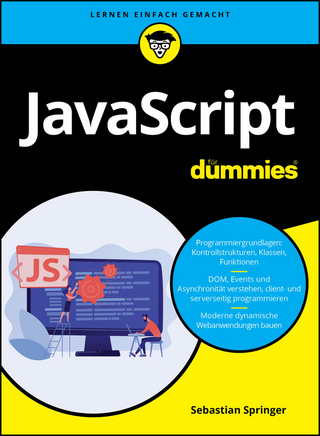
Learning AngularJS
O'Reilly Media (Verlag)
978-1-4919-1675-9 (ISBN)
- Lieferbar (Termin unbekannt)
- Versandkostenfrei innerhalb Deutschlands
- Auch auf Rechnung
- Verfügbarkeit in der Filiale vor Ort prüfen
- Artikel merken
Along with a conceptual understanding of the framework, you’ll also gain direct experience with AngularJS by building a sample application throughout the book. If you’re familiar with JavaScript, web development, and software design concepts and patterns, this book is the perfect way to get started.
- Understand how AngularJS differs from other MVC frameworks
- Learn about AngularJS controllers, views, and models by diving into the book’s sample project
- Connect your working application to public REST services
- Build the application’s security layer with non-REST AngularJS services
- Explore the basics of building and testing AngularJS directives
- Use AngularJS as part of the MEAN stack (MongoDB, ExpressJS, AngularJS, and Node.js)
- Discover how search engine optimization relates to AngularJS applications and sites
Ken Williamson is a software engineer and architect with over twenty years of experience in the technology industry. He holds a BS in Computer Science from Kennesaw State University, and is the founder of several Open Source projects including Ulbora CMS. You can find Ken at www.ken-williamson.com.
Chapter 1Introduction to AngularJS
JavaScript Client-Side Frameworks
Single-Page Applications
Bootstrapping the Application
Dependency Injection
AngularJS Routes
HTML5 Mode
Modern Search Engines
AngularJS Templates
AngularJS Views (MVC)
AngularJS Models (MVC)
AngularJS Controllers (MVC)
Controller Business Logic
Integrating AngularJS with Other Frameworks
Testing AngularJS Applications
Conclusion
Chapter 2The IDE and AngularJS Projects
The IDE
Editing the HTML Code
Editing the JavaScript Code
Creating the Templates
Running the Applications
Testing AngularJS Applications in the IDE
JsTestRunner
Karma Test Runner
Protractor
Conclusion
Chapter 3MVC and AngularJS
The Old Way
A New and Better Way
Testing Considerations
Responsive Design Considerations
Conclusion
Chapter 4AngularJS Controllers
Initializing the Model with Controllers
Adding Behavior with Controllers
Controller Business Logic
Presentation Logic and Formatting Data
Form Submission
Using Submitted Form Data
JS Test Driver
Testing with Karma
End-to-End Testing with Protractor
Conclusion
Chapter 5AngularJS Views and Bootstrap
AngularJS Templates
Creating the Blog Project
Adding a New Blog Controller
Adding a New Blog Template
Twitter Bootstrap
Adding a Bootstrap Menu
Adding Mock Blog Data
Using CSS3 to Style the Page
Adding Styles and Presentation Logic
Viewing the Blog Post
Running the Blog Application
Testing with Karma
End-to-End Testing
Conclusion
Chapter 6AngularJS and REST Services
REST Services
AngularJS and REST Services
Ways to Create AngularJS Services
Ways to Communicate with REST Services
Updating the Project for REST
REST Services and Controllers
The JSON Response
List Services
Testing Services with Karma
End-to-End Testing
Conclusion
Chapter 7AngularJS Models
Public REST Services
Changes to the Controllers
Model Properties
Blog Application Public Services
Modifying the HTML
Modifying App.js
Modifying the Controllers
Running the Application
Testing Services with Karma
End-to-End Testing
Conclusion
Chapter 8Services and Business Logic
Handling User Authentication
Using Basic Authentication
Creating AngularJS Services
Holding User Credentials
Checking User Credentials
Deleting User Credentials
Retrieving User Credentials
Blog Application Business Logic
Using the Business Logic
Testing Services with Karma
End-to-End Testing
Protractor Configuration
Protractor Test Specification
Protractor Testing
Conclusion
Chapter 9AngularJS Directives
The HTML Compiler
What Are Directives?
Building Custom Directives
Naming Conventions for Directives
The Restrict Option
The Template URL
Template Attributes
Adding the Custom Directive
Passing the Title Attribute
Running the Blog Application
Testing Directives with Karma
End-to-End Testing
Conclusion
Chapter 10AngularJS Security
Authentication
Adding a Login Service
Adding a Login Controller
Security Modifications to Other Controllers
Adding a Logout Controller
Adding a Login Template
Adding New Routes
Adding a Logout Link
Running the Blog Application
Testing with Karma
End-to-End Testing
One Last Point on Security
Conclusion
Chapter 11MEAN Cloud and Mobile
Local Deployment
Installing Node.js, npm, and MongoDB
Installing the NetBeans Node.js Plugin
The MEAN Application
Node.js Public Folder
MEAN Services
MEAN Blog Controllers
MEAN Blog Templates
Adding Comments
Adding Blog Entries
Adding New Routes
Adding Node.js Dependencies
Running the Blog Application Locally
Testing with Karma
End-to-End Testing
MEAN Deployment to the Cloud
Testing the Cloud Blog
Mobile Version
Conclusion
Chapter 12AngularJS and SEO
Old Versus New AngularJS SEO
Getting Found by Search Engines
Google Webmaster Tools
Adding a Sitemap
Microformat Tags
Building Clean Client Code
Building Fast REST Services
Conclusion
| Erscheint lt. Verlag | 28.4.2015 |
|---|---|
| Verlagsort | Sebastopol |
| Sprache | englisch |
| Maße | 184 x 231 mm |
| Gewicht | 376 g |
| Einbandart | kartoniert |
| Themenwelt | Informatik ► Web / Internet ► JavaScript |
| Schlagworte | AngularJS (Framework) • JavaScript • Webentwicklung |
| ISBN-10 | 1-4919-1675-3 / 1491916753 |
| ISBN-13 | 978-1-4919-1675-9 / 9781491916759 |
| Zustand | Neuware |
| Haben Sie eine Frage zum Produkt? |
aus dem Bereich


